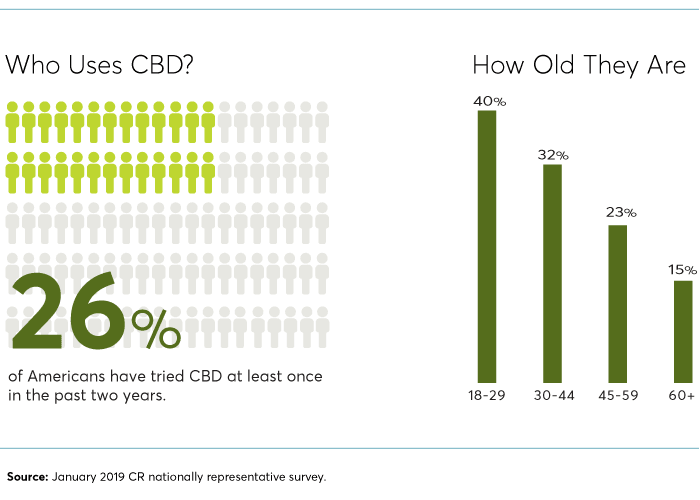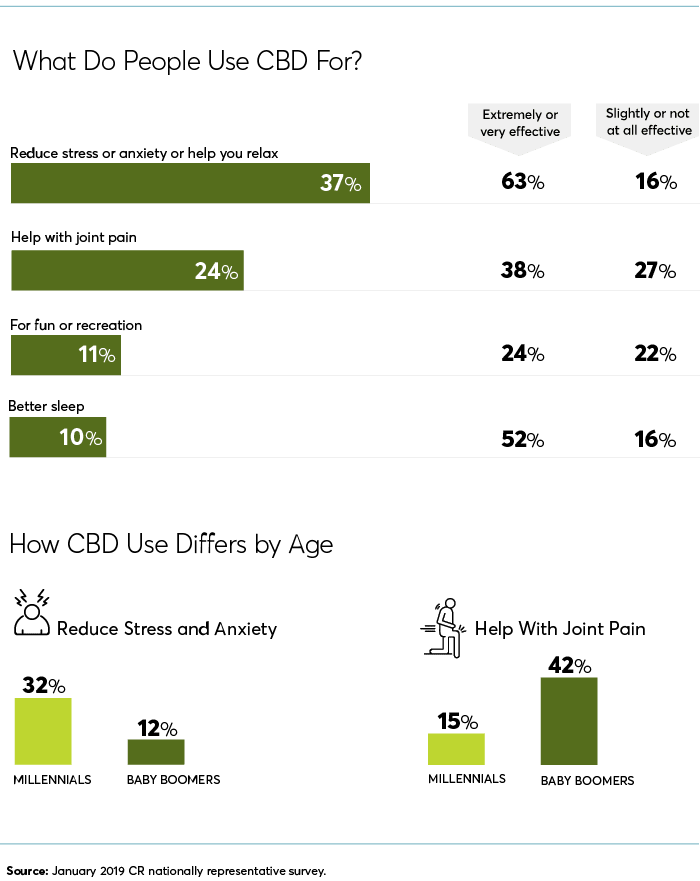By Consumerreports.com
A mother uses CBD to treat her son’s seizures. A veteran hopes it will help her wean off opioids. A dietitian says it helps her sleep through the night. Even a pet owner uses it to calm his anxious Saint Bernard. These are just some of the estimated 64 million Americans who have tried CBD, or cannabidiol, in the past 24 months, according to a January 2019 nationally representative Consumer Reports survey of more than 4,000 Americans.
The survey found that more than a quarter of people in the U.S. say they’ve tried CBD—a compound in marijuana and hemp that doesn’t get you “high”—for a slew of mental and physical reasons. One out of 7 of those people said they use it every day.
Americans of all ages are using it, too. It’s most popular among people in their 20s, with 40 percent of them saying they have tried CBD. But so have 15 percent of people 60 and older. And our survey respondents also said it helped. Most of those who tried CBD reported that it was effective, especially among those who used it for anxiety. In some cases, they said CBD allowed them to eliminate over-the-counter or prescription drugs, including opioids.
Sold in pill form, oils, tinctures, topical lotions, and even in bottled water, coffee, beer, and cosmetics, CBD is already in hundreds of products on the market. And that could soon rise sharply, in part because of recent changes in federal law that allow U.S. farmers to legally grow hemp, according to the Brightfield Group, a market research firm specializing in cannabis. The company expects the CBD market from hemp alone to grow to $22 billion by 2022, up from $327 million in 2017. (Watch our video below on the emergence of CBD.)
At the same time, more states are legalizing marijuana itself for medical use and, increasingly, for adult recreational use. More than a quarter of Americans now live in the 10 states, plus Washington, D.C., where recreational use is legal, including California, Colorado, and Massachusetts. And others, including New Jersey and New York, could be joining the list soon.
More than three-quarters of U.S. adults favor legalizing the medical use of marijuana, according to a separate nationally representative 2018 CR survey of more than 1,000 U.S. adults, and half support legalizing recreational use.
While more Americans may be using CBD and marijuana, the laws and regulations governing both remain confusing and inconsistent.
For example, although marijuana is now legal to one extent or another in 33 states, it remains illegal federally. And despite the loosening of rules governing the growing of hemp, some cities and states have recently cracked down on food that contains CBD, calling it an unapproved food additive.
Meanwhile, some scientists, doctors, and public health officials question what’s really known about the benefits—and risks—of CBD by itself, and of marijuana, too. In fact, the growing interest in marijuana has renewed concerns about its safety, ranging from impaired driving to mental health problems.
If you decide to try cannabis, here’s what to know about its potential health benefits and risks, as well as how to stay safe and avoid potentially dangerous products.
Until recently, CBD was an underappreciated compound in cannabis. Growers actually tried to breed it out of plants, seeking strains with higher THC levels, according to Martin Lee, a cannabis historian. It wasn’t until 2009, he says, that growers came across plants containing large amounts of CBD.
Some research suggests that CBD may affect the “endocannabinoid system,” a series of receptors found throughout the body that seem to interact with various compounds in cannabis, including CBD, and some of which are related to feelings of anxiety and pain, or that help regulate the body’s sleep-wake cycles.
CBD’s most far-reaching health effect may be its anti-inflammatory properties. And not just in a knee or hip joint, but throughout the body, including the central nervous system and the brain, says Joseph Maroon, M.D., a clinical professor of neurological surgery at the University of Pittsburgh Medical Center, who has investigated the link. In a 2018 review, he and colleagues said such effects could possibly reduce anxiety, depression, seizures, and post-traumatic stress disorder (PTSD), and even benefit people who have had a concussion.
The best studies of CBD so far have been in the area of seizures, and the results were strong enough that last year the Food and Drug Administration approved a prescription version of CBD, called Epidiolex.
CR’s survey also provides some support for CBD’s possible health benefits. Almost three-quarters of people who took CBD said it was at least moderately effective for the main reason they took it, with 48 percent of them saying it was very or extremely effective.
And CBD seemed to work well for some of the most common problems, including easing stress and joint pain, and improving sleep. Our survey also suggests that side effects are uncommon; almost three-quarters said they experienced no side effects.
Also promising: 22 percent of people who took CBD for one of the health problems we asked about said it helped them replace prescription or OTC drugs, with more than a third of them saying they used it to replace opioids. And some researchers across the U.S. are now studying whether CBD (alone or in combination with THC) could be a tool in the fight against the ongoing opioid crisis.

Where and How CBD Is Sold
You might find CBD online or in local health-food stores or CBD-specific retailers. In CR’s survey, edibles including gummies and other infused foods and drinks were the most popular way to get CBD, with oils or drops, vape pens, and rubs also common.
Look for products that show how much CBD is in each dose, not just the whole product, says Mitch Earleywine, Ph.D., a professor of psychology at the University at Albany, State University of New York, who has studied the medicinal use of CBD.
Dosages, which are expressed in milligrams, or mg, vary depending on the form of the product, and experts often suggest starting with products that have relatively low doses. For example, with tinctures, Earleywine suggests generally starting with a product that has just 10 mg per dose.
Avoid products that make sweeping health claims, because they’re often inaccurate and illegal.
If you vape, know that the concentrated oils used can contain a solvent called propylene glycol. When burned at high temperatures, it can degrade into formaldehyde, which can irritate the nose and eyes and could increase the risk of asthma and cancer. So consider CBD vape pens that advertise “solvent-free oils.”
To date, few states require testing of CBD products sold online or in retail stores. The best way to find out whether a product has what is claimed is to ask for its COA, or certificate of analysis.
That document shows how a product performed on tests, typically commissioned by the manufacturer, checking for CBD and THC levels, and whether it contains contaminants like heavy metals or pesticides. If an online manufacturer or a retail store doesn’t have the information or refuses to share it, look for another product.

